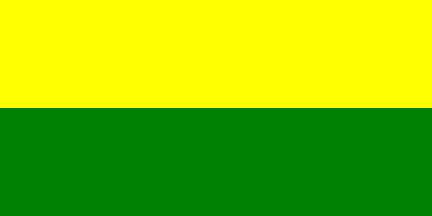 image by Dov Gutterman, 13 July 2002
image by Dov Gutterman, 13 July 2002
Last modified: 2024-07-06 by daniel rentería
Keywords: antioquia | angostura | norte | zona norte |
Links: FOTW homepage |
search |
disclaimer and copyright |
write us |
mirrors
 image by Dov Gutterman, 13 July 2002
image by Dov Gutterman, 13 July 2002
Corregimiento:
See also:
Based on image at
www.gobant.gov.co.
Dirk Schonberger, 13 July 2002
Translated from
angostura-antioquia.gov.co:
"The colours Yellow and Green of this flag are distributed
in horizontal stripes in equal proportion. The yellow means the
gold wealth of the region. The green means the fertility of its
fields, abundance and territorial extension."
Jairo Alonso Méndez Méndez, 17 November 2007
A variant of the flag of Angostura was displayed during a broadcast of H13N
tv news. The flag featured the plain flag with
the coat of arms in the middle, as seen in this image:
http://angosturaantioquia.micolombiadigital.gov.co (source:
http://www.angostura-antioquia.gov.co/municipio/nuestro-municipio).
The official description of the symbols is as follows (translated from the
original, in Spanish):
"Flag:
Yellow: stands for the gold found in
the region
Green: stands for the fertile grounds, abundance and extension of
its territory
Coat of Arms:
The coat of arms displays several elements
of the Antioquia people. The economy is represented in coffee, sugar cane,
fruits and cattle, which also represent its hardworking people altogether. It
also displays the coat of arms of the Eusse familiy, with its most important
representative,
Beato Mariano de Jesús (colloquially known as "El Beato Padre
Marianito". Poetry from Porfirio Barba Jacob, Francisco Jaramillo Medina and
others, is also included in the lira around the coat of arms. The cornucopia
stands also for the gold found in the region."
Source:
http://www.angostura-antioquia.gov.co/municipio/nuestro-municipio
Image cropped image from screenshot of tv broadcast at 0:59, source:
https://h13n.com/fue-declarada-la-calamidad-publica-en-el-municipio-de-angostura/
and
https://www.youtube.com/watch?v=QaOT1b4YdIA).
Esteban Rivera, 30
May 2018
In fact Llanos de Cuivá (English: Cuiva Plains) is derived from the
Cuiba indigenous tribe.
Additionally, this piece of land is part of and borders several
Municipalities, as follows: Angostura, Yarumal, and Santa Rosa de Osos.
Source: https://corregimientos.antioquia.gov.co/wp-content/uploads/2023/08/Co.-Llanos-de-Cuiva.pdf
Esteban Rivera, 6 June 2024
 image by Daniel Rentería, 5 July 2024
image by Daniel Rentería, 5 July 2024
Llanos de Cuiva is the only corregimiento in the Municipality of Angostura. Its flag is presented here:
https://corregimiento-llanos-de-cuiva.webnode.com.co/news/bandera/
A banner measuring 1.80 meters x 0.9 meters wide divided into three strips, the first strip being green in color, in the shape of a mountain, presents the 2,800 altitude above sea level of the corregimiento. This rises to 10 cm in the middle of the flag, its top being circular. The second peak-shaped strip is blue, starts 40cm from the edges of the flag and its peak rises to the upper end of the flag. The third strip includes two triangles formed by a blue peak and is colored white.
Author: Alba Doris Medina
Valentin Poposki, 6 June 2024; quoted text by the Corregimiento of Llanos de Cuiva (translated)
.gif) image from https://corregimiento-llanos-de-cuiva.webnode.com.co/news/escudo/
image from https://corregimiento-llanos-de-cuiva.webnode.com.co/news/escudo/
Presented at:
https://corregimiento-llanos-de-cuiva.webnode.com.co/news/escudo/
*The left third coasts on a plateau-mountain crossed by a road. The sphinx of an Indian appears in a cloud, a symbol of the first inhabitants, the Cuivá Indians, who gave rise to the name of the town. It rises from the middle of the shield phase to the upper right edge of the shield, in the shape of a triangle.
*The right third is formed with the same plateau-mountain of the first third, crossed by a paved road, a cow, a mushroom and a tree, which represents the plateau, the industry, the progress, the agriculture of the corregimiento. The sun represents dreams, ideals and future projects. It rises from the middle of the base of the shield to the upper left corner of the shield in the shape of a triangle.
*The central third has a wax palm, an emblematic tree of Colombia which adorns many places in our plains region. It also has a blue star that represents the richness of the 5 large water sources in our district.
Author: Alba Doris Medina
Valentin Poposki, 6 June 2024; quoted text by the Corregimiento of Llanos de Cuiva (translated)